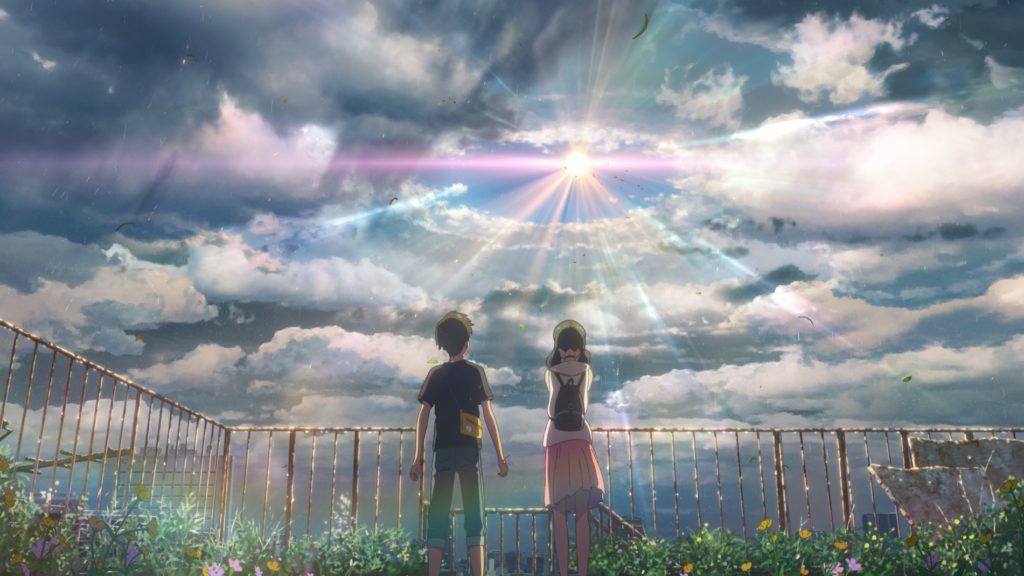Weathering With You's climate change love story is a little too easy
Makoto Shinkai's protagonists find love in the midst of climate catastrophe — but we don't see what happens next


Makoto Shinkai's new anime film Weathering With You offers love and magic in a world ravaged by climate change. But, despite the beauty the film finds in destruction, it never fully answers the question of what happens to love in a world that's sinking.
In Weathering With You, Shinkai's followup to the critically acclaimed record-breaking box-office success Your Name, a high-school student named Hodaka runs away from home to try to make a living in Tokyo, but the city is plagued by seemingly endless rain. Getting a job with a small publishing company that deals in conspiracy theories and the occult, he learns about weather maidens, girls who have the ability to change the weather, and then meets one, a teenage girl named Hina. Together, Hodaka and Hina form a business where they take requests from people who want the touch of sunshine that Hina can summon — for weddings, parties, outdoor markets — for payment. But when the two get tailed by cops and Hina reveals that her body is transforming as a result of her powers, the weather in Tokyo turns apocalyptic, and our protagonists struggle to find shelter from the authorities and the natural disaster brewing outside.
Though climate change is never explicitly mentioned in the film, the issue is unquestionably part of the story's DNA. Shinkai himself has stated that he created this film with our climate crisis in mind. But the film adheres to its central component of magic as the cause and resolution of the disaster. A priest reveals that the strange weather attacking the city is not as unique an occurrence as people would believe; it is perhaps a singular event in recorded history, but there exists a long history before that, when the weather went wild. In those instances, the priest reveals, weather maidens, who are linked to the skies, served as sacrifices, and the weather returned to normal. Later in the film, as the streets flood and it starts to snow — despite it being late summer — Hina decides to sacrifice herself to fix the weather, and the skies immediately clear, and the sun comes out. Magic is everywhere — not simply in the movie's narrative but in its design: drops of water glisten and sparkle, the sun breaks through the clouds with impossibly bright slivers of light, a prism of colors in brisk pinks, purples, and blues. And we see the world of the sky, a kind of inverse mirror world of liquid sea creatures and a spring green field of grass.
The Week
Escape your echo chamber. Get the facts behind the news, plus analysis from multiple perspectives.

Sign up for The Week's Free Newsletters
From our morning news briefing to a weekly Good News Newsletter, get the best of The Week delivered directly to your inbox.
From our morning news briefing to a weekly Good News Newsletter, get the best of The Week delivered directly to your inbox.
This other world in the sky is an intoxicating vision, though we don't stay there for long, among the fish and whales made of water. It creates a kind of cognitive dissonance in the film, which is full of a grim fear of environmental disaster but posits, in the magical logic of this world, that this disaster is linked to the utter beauty and fantasy of the sky world. Even more, the implication is that this crisis makes sense, and is even warranted, in the natural functioning of this sky world. Every once in a while the sky opens up until a water maiden sacrifices herself, and all is normal, until the next time.
When Hodaka and Hina ultimately decide not to have Hina sacrifice herself (after Hina's initial attempt and a subsequent rescue by Hodaka), the story is valuing the preservation of the couple over the preservation of the world. The move isn't necessarily a negative one — in fact, it prevents the story from falling into the trope of having the magical girl selflessly sacrifice herself to save the day, a messianic figure erasing any culpability of the people around her. It also isn't the first time Shinkai has made this choice: in Your Name, his protagonists transcend time and space, in the face of a different natural disaster, to find and save each other. In that case, love easily skipped over the obstacle, which was more a combination of chance and human error, but it's difficult to see the climate disaster in Weathering With You — one that's very real to us at the moment — in the same light, and thus more difficult to imagine how its protagonists can survive in such a world.
Shinkai's larger world takes a backseat to the world of Hodaka and Hina, who are together in the end, but Shinkai also doesn't let everything around them totally fall away. The movie ends three years after it began, and we see a Japan nearly sunken into the sea, the Rainbow Bridge almost completely submerged, while the sky above it is a murky gray. The image — and what it represents — is striking, but is then superseded by the last bit of plot. Hodaka and Hina joyously reunite, and the story ends with the two teenagers in love. The kids make the decision that they won't sacrifice their love to save the city — that's not their responsibility, and Hina has a right to live her own life — but neither they nor the film ask how can they go on. What kind of future can they have?
Shinkai's films have plenty of heart and the talent to capture it narratively and visually, but a film with characters whose situation is linked to that of a progressively sinking world cannot so easily resolve itself with an answer of love and communion before the credits roll. The couple makes a choice to get their happy ending, but there's a cost in the form of this world in crisis, which isn't so far off from our own.
A free daily email with the biggest news stories of the day – and the best features from TheWeek.com
Perhaps the meta irony of the film is this very mode of storytelling in relation to its politics. It's lovely to sit down in a theater and watch a happy story about love, but if just outside the theater the world is still sinking, like the world of Hodaka and Hina, then after the fantasy and the magic and the love is over, what exactly happens next?
Want more essential commentary and analysis like this delivered straight to your inbox? Sign up for The Week's "Today's best articles" newsletter here.
Maya Phillips is an arts, entertainment, and culture writer whose writing has appeared in The New York Times, Vulture, Slate, Mashable, American Theatre, Black Nerd Problems, and more. She is also a web producer at The New Yorker, and her debut poetry collection, Erou, is forthcoming in fall 2019 from Four Way Books. She lives in Brooklyn.
-
 Venezuela’s Trump-shaped power vacuum
Venezuela’s Trump-shaped power vacuumIN THE SPOTLIGHT The American abduction of Venezuelan President Nicolás Maduro has thrust South America’s biggest oil-producing state into uncharted geopolitical waters
-
 Most data centers are being built in the wrong climate
Most data centers are being built in the wrong climateThe explainer Data centers require substantial water and energy. But certain locations are more strained than others, mainly due to rising temperatures.
-
 ‘Maps are the ideal metaphor for our models of what the world might be’
‘Maps are the ideal metaphor for our models of what the world might be’Instant Opinion Opinion, comment and editorials of the day
